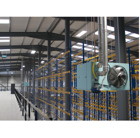Destratification for efficiency

Most MBS readers will be familiar with the phenomenon of thermal stratification, a frequent occurrence in high-roofed buildings where the natural buoyancy of warm air results in its accumulation at high level. Heating this unoccupied area of the space is clearly inefficient, exacerbated by colder air at high level being pushed downwards into the occupied zone by the warm air, increasing the demand for heating.
To put this into perspective, the occupied zone in most buildings is around 2m from floor level, yet ‘shed’ type buildings used in logistics, manufacture and retail typically have pitched roofs with an average height of 5m to 7m. This can result in a temperature differential as high as 5⁰C or more between the occupied zone and the roof space.
To make matters worse, many such buildings have relatively poor thermal insulation at roof level, so that heat losses through the building fabric can be significant. The higher the temperature of the air at roof level, the greater the thermal gradient between the inside and outside air, and the faster the heat losses.
Reduce differences
This can be illustrated by considering some typical conditions. If the set point temperature for the occupied space is 19°C and there is a 5°C temperature differential between it and the roof space, the air at roof level will have a temperature of around 24°C. On a cold winter’s day, with an outdoor temperature of -1°C, there will therefore be a temperature difference of 25°C.
However, if destratification is used to ensure even distribution of warm air, the air at roof level will be at the set point of 19⁰C. Thus, the temperature differential is reduced to 20⁰C, the temperature gradient is shallower and the rate of heat loss is slower.
A similar situation arises in relation to air-tightness, as many such buildings are quite ‘leaky’, so that warm air rising to the roof can escape to the outside through these leakage points. As well as the direct loss of heat energy this represents, it also creates a small negative pressure that draws cold air into the building through lower level leakage points. This ingress of cold air will reduce the temperature in the occupied zone so that more energy is consumed by the heating system to restore the set point.
Such issues are mitigated by integrating destratification fans into the warm air heating system. A destratification system minimises the temperature differential between air in the occupied zone and that in the roof space. This will often make it possible to maintain the required temperature with fewer warm air heaters, reducing capital and running costs.
 |
| Temperatures shown are for a typical building |
 |
|
Destratification: greater comfort and better energy efficiency |
Also, in many such applications the heating system won’t be the only source of heat energy. Manufacturing and production processes often generate heat, as do crowds of shoppers in a busy retail outlet. With a destratification system, this heat is also evenly distributed through the space, potentially reducing the load on the heating system and delivering further energy savings.
In parallel, destratification improves comfort levels by reducing or eliminating hot and cold spots in the occupied zone. Destratification fans can also be used without the heating in warm weather to provide cooling flows of air throughout the space.
Design and control
Optimal design is essential in maximising the benefits of destratification, so it’s important to understand the options available and select the most suitable fan type for the project.
For ceiling heights between 5m and 8m, using low velocity blade or propeller fans to churn the air will typically be the best solution. In spaces that are 8m to 20m high it will be necessary to direct significant amounts of air at high speed towards the occupied zone using higher velocity axial fans.
Whichever type of fan is selected for the project, control is also important. Typical options include only operating fans when the heating is on; controlling the fans independently of the heating; linking fan operation to air temperature at ceiling height; and controlling the speed of the fan to prevent draughts.
Air rotation
In some cases, destratification fans will not be appropriate because of the layout of the space – such as when high-density racking is in use. An alternative is air rotation heating, a technology that was developed in the USA some 40 years ago but is still relatively new to the UK.
Air rotation heaters use high efficiency axial fans which move large volumes of air through the space at relatively low temperatures. Typically, the air within the space is recycled through the heater every 30 minutes, minimising the effects of stratification. The relatively low temperatures used by air rotation heaters also maximise the potential for high efficiencies through lower temperature rises.
Importantly, their ability to maintain set-point temperature is generally not affected by how the space is configured, so layouts can be changed without reconfiguring the heating system.
Destratification heat recovery isn’t just a matter of installing a few fans at high level.The design needs to take account of many different factors. These include the size and layout of the space, the nature of the building fabric and the activities within that space – as well as the type of heating system being used.
For these reasons it is advisable to team up with a supplier that has experience ofsuch projects to ensure the best solution for the end customer.
Paul Fox is general sales manager with Powrmatic







